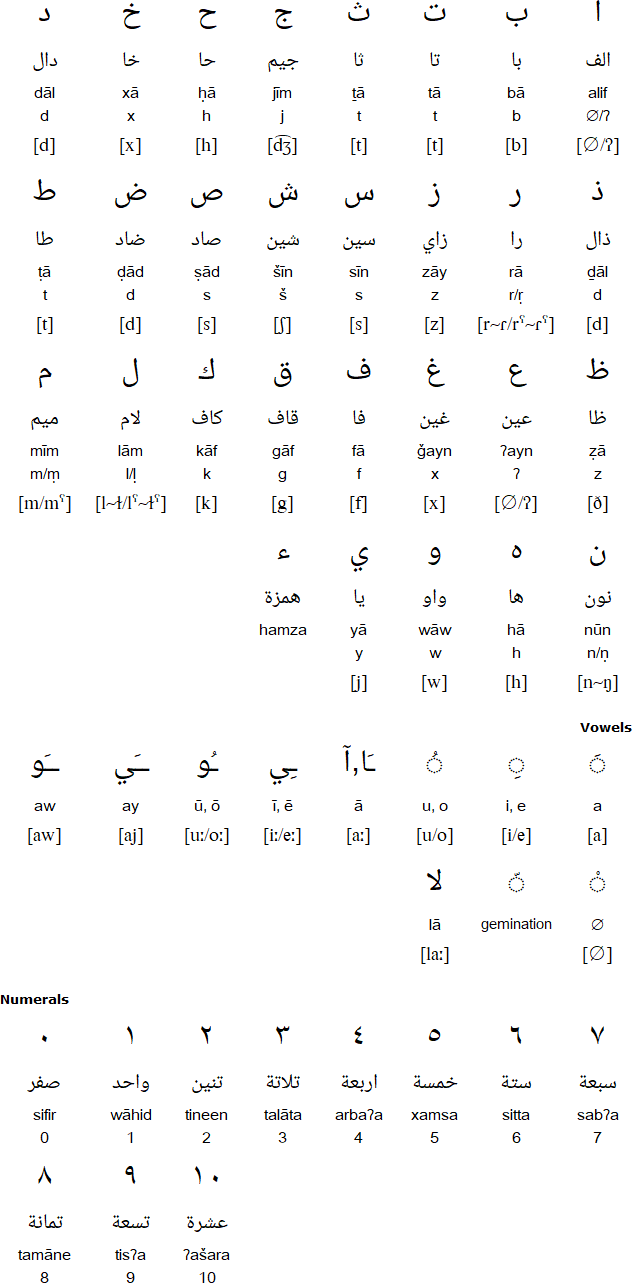Chadian Arabic is a variety of Arabic spoken by about 2 million people around Lake Chad, mainly in Chad, and also in Nigeria, Cameroon, the Central African Republic, Niger, Sudan and South Sudan.
There are about 1.6 million speakers of Chadian Arabic in Chad, particularly in central and southern parts of the country, and it is used as a lingua franca by 40-60% of the population of Chad. There are 200,000 speakers of Chadian Arabic in Borno state in the north east of Nigeria, 145,000 in the Far North region of Cameroon, 63,000 in the Central African Republic, and 12,000 in the Diffa region in southeastern Niger. There are also Chadian Arabic speakers in the southwest of Sudan in Kordofan and Dafur, and in the north of South Sudan.
Chadian Arabic is also known as Shuwa (Arabic), Shua (Arabic), Suwa (Arabic), Baggara Arabic, Western Sudanic Arabic or Chad Arabic. It is written with the Arabic alphabet or the Latin alphabet, and is taught in primary schools in Chad.
Chadian Arabic was first documented in 1913 by Henri Carbou, a French colonial adminstrator who wrote a grammar of the Ouaddaï highlands dialect. In 1920, Gordon James Lethem, a British colonial administrator in Nigeria, wrote a grammar of the Borno dialect.

Download an alphabet chart for Chadian Arabic (Excel)
Details provided by Michael Peter Füstumum
Information about Chadian Arabic | Numbers | Chadian Arabic courses on: Amazon.com and Amazon.co.uk [affilate links]
Information about Chadian Arabic
https://en.wikipedia.org/wiki/Chadian_Arabic
https://www.ethnologue.com/language/shu
https://www.tala-al-nuur-fi-tchaad.com/en/learn-chadian-arabic
https://loispiration.com/2020/08/11/chadian-arabic-language/
https://en.wikivoyage.org/wiki/Chadian_Arabic_phrasebook
Algerian, Bedawi, Chadian, Cypriot, Egyptian, Gulf, Hassaniya, Hejazi, Lebanese, Libyan, Modern Standard, Moroccan, Najdi, Sudanese, Syrian, Tunisian
Akkadian, Amharic, Arabic (Algerian), Arabic (Bedawi), Arabic (Chadian), Arabic (Egyptian), Arabic (Gulf), Arabic (Hassaniya), Arabic (Hejazi), Arabic (Lebanese), Arabic (Modern Standard), Arabic (Moroccan), Arabic (Najdi), Arabic (Sudanese), Arabic (Syrian), Aramaic, Argobba, Assyrian / Neo-Assyrian, Canaanite, Chaha, Chaldean Neo-Aramaic, Ge'ez, Hadhramautic, Harari, Hebrew, Himyaritic, Jewish Neo-Aramaic, Maltese, Mandaic, Nabataean, Neo-Mandaic, Phoenician, Punic, Qatabanic, Sabaean, Sabaic, Silt'e, Syriac, Tigre, Tigrinya, Turoyo, Ugaritic, Western Neo-Aramaic
Page created: 02.11.21. Last modified: 03.11.21
[top]
You can support this site by Buying Me A Coffee, and if you like what you see on this page, you can use the buttons below to share it with people you know.

If you like this site and find it useful, you can support it by making a donation via PayPal or Patreon, or by contributing in other ways. Omniglot is how I make my living.
Note: all links on this site to Amazon.com, Amazon.co.uk
and Amazon.fr
are affiliate links. This means I earn a commission if you click on any of them and buy something. So by clicking on these links you can help to support this site.
[top]